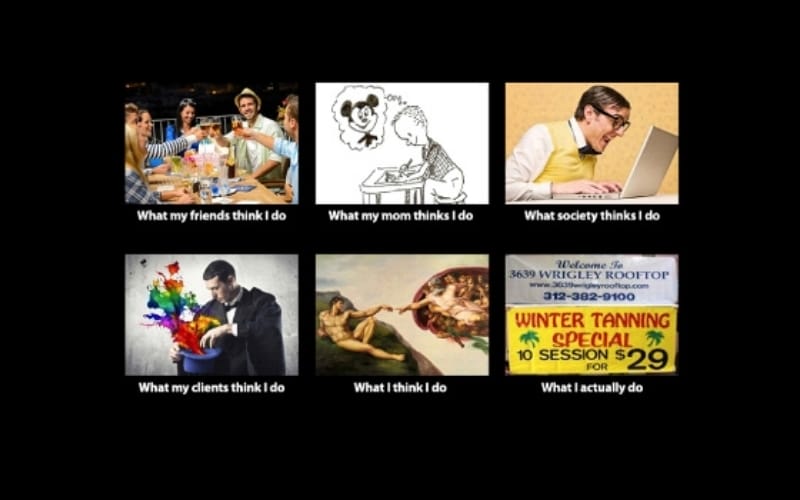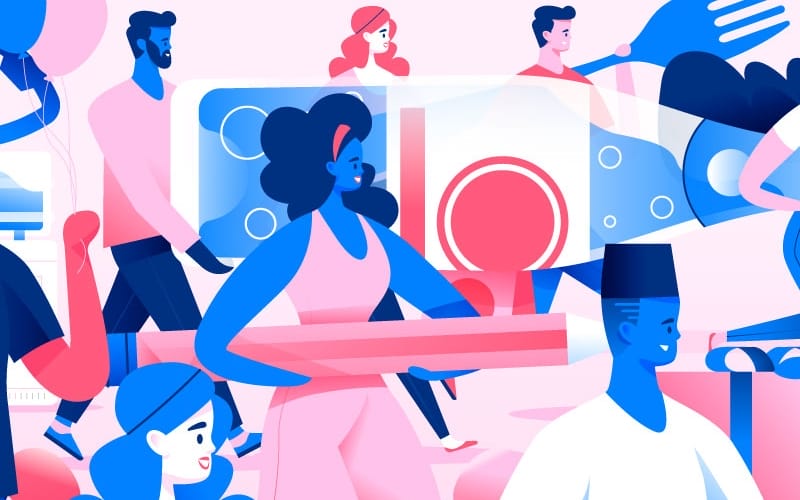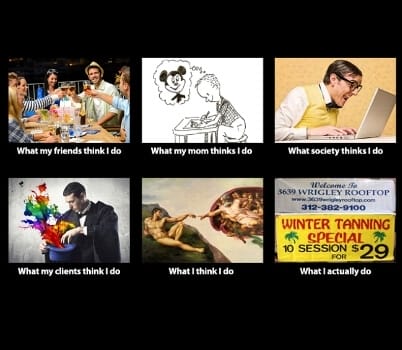
Felt guilty when by smash that dream bubble with the reality of a typical day a graphic designer might face.
If you thought that a graphic designer had an easy job, the typical preconceived notion is that all a graphic designer needs to know is how to draw.
Students seem shocked to learn that they need to pay attention in English and Math class because a graphic design job depends on both subjects. Also you need to have good communication skills in order to sell your ideas.
A graphic designer may find their work environment is actually more production based than they may be expecting. Teacher deadlines can be very accommodating. Students may have a week to come up with some ideas. From there they may have a couple of weeks to fine tune the concept, then possibly more time to present the final design to the teacher.
Then comes the real life talking! The real world has much tighter deadlines! We live in a fast-paced world, and as such, designers find that clients want everything Right NOW!
Keep in mind design work is very subjective. No matter what degree you hold or how much experience you’ve acquired, there will inevitably come a time when someone with absolutely no design background will tear apart your design.
But that doesn’t mean that you give up, instead you have to survive!
Want to survive a career that is based on people’s opinions?
Well, you’ll need a thick skin. Go ahead and form your own opinions of what a graphic designer’s job should look like, and strive to make them a reality! Despite the challenges graphic designers face, working in the field is exciting and constantly changing.

So, what makes a good relationship between Client and Designer?
Working in a big design project can be a stressful task, but like most things in life, a little collaboration can make things done! The client and the designer will be drowning in a bunch of drafts & proofs of the project along the way to find the perfect design. This can be a trying time, especially when you don’t see eye to eye on certain side of the design. Don’t stress! Debating about details and trusting each other can lead to a stronger project in the end.
Always remember, both of you are experts in your field. The client knows more about their business than anyone else, and the information they hold can be priceless to the project.
Before the project begins, the client should try to think about their main goals for the project and how they want it to influence their business.
They should also reflect on some of the details that might help the designer to create something that is unique to them.
They always ask themselves: What makes my business special?
Does something about the area I’m in make it unique?
Asking yourself things like these should help the client to imagine what they need.
After the client conceive what they need, the project moves over to the designer. The client supplies the designer with all the information that they brainstormed and it’s off to the competition! So what happens when the first couple proofs come back and it’s not absolutely perfect?
That’s normal, most design projects take some back and forth before coming to the final result. Remember that as a client, you hired a professional to assist you. Throughout this process they’re going to offer their input and advice as you move forward, so try to be open to it! Take advantage of the designer’s experience in the field by asking questions and being active in the project.
The best thing to remember is that everybody is on the same team. Both the client and the designer want this to be the best project it can be. This takes trust and respect from both parties to make it happen. So take careful consideration of each other’s opinions and work to make something really great. With a bit of collaboration, the next design project you will work on will go Smoothly!
Be patient, Be professional and you will survive it’s all about working smart in collaboration!
Three important tips for clients starting a project with your designer

By https://dribbble.com/noamweiner
Most of designer, have worked on many projects that didn’t go as smoothly as they had hoped, which means multiple proofs, and in some cases, a complete redo. Usually the biggest reason for wasted time and energy is the lack of communication. Sometimes clients wrong believes that designers blindly know what they want, so they give them the project with little or no information or direction and tell them
“work your magic”.
There are many creative roads that can be taken, so giving designers enough direction will help to start design inspiration.
The more information designers can collect from the customer, the better equipped they will be to deliver a product that gets results.
Those three simple steps will save time, money and make your designer happy:
Supply all the information from the start.
When designers start a project, they suppose the client has provided all the available information they had .
Well that’s wrong! Don’t assume that they know your company as well as you do! If they don’t have a regular working relationship with your company, they probably won’t know your products and services, or even the contact information or address of all your business locations.
Sure, designers can gather some information from your website or Facebook page, but researching that just adds time to the job. If your job was quoted for two hours of design time, wouldn’t you rather have more time devoted to the creative aspects of the project instead of the research? Your designer certainly does!
If you have an idea or opinion before concept of what you would like the piece to look like, discuss it with your designer.
Give Your designer some solid ideas of what kind of artwork you visualize, or maybe a specific theme that the artwork could follow.
Many customers search Google images or stock photography sites and email examples to the designer. Designers doesn’t mind that, but they do reserve the right to suggest other images based on our creative instinct. mysterious or abstract suggestions may make it more difficult for the designer to come up with a solution. Be more precise with your request.
You can save time and make it easy on the designer by supplying all of the copy in a Word document. Don’t bother formatting the text or adding color to headlines, we’ll take care of that.
Don’t forget to add notes as necessary. For instance, mark in the Word document where you might like to see a certain photo, or highlight text that can be eliminated, if necessary. Be sure to indicate what is the most important aspect to emphasize. Is it the rate? The quality of your product? Or maybe the service after the sale? A professional designer will look at all copy and make their own definition of what is most important, but they can’t guarantee that it will work with what you had intended to highlight.
Descriptive feedback
Rarely, the first proof a designer provides will be perfect.
All the time there will be revisions that need to be made. At this stage of the project, customer input is fatal. Designers may love abstract artwork, but when it comes to client feedback they are looking for crystal clear instructions. Don’t just say “I don’t like it”. Be specific! By “it” do you mean the layout? The images? The colors used? Help your designer break down the ingredients of the piece to determine the area that you feel need improvement.
Clients should be as adjective as possible when providing feedback to the designer. Say for instance, the headline needs to be bigger. Or the color you’ve chosen looks too much like our competitor’s branding. Designers are open to other points of view, so we are not offended when clients return a proof with revisions. The clearer those revisions are, the fewer proofs will be necessary.
Descriptive feedback is a critical stage for your design.
Be faithful in your designer’s abilities
Don’t take it personally if they take freedom with some of the suggestions you make. It may appear that they are ignoring you, but based on designers knowledge or experience, they know that the suggestion you made will not turn out as you had imagined.
For an example, if you provide a photo for a billboard design, we will be most concerned with its size and resolution. We want to make sure overall quality, so if the photo you provided was the size of a postage stamp, we know that it can’t be increased much without becoming blurry.
So, your designer will request a new photo or suggest a similar stock photo. Ultimately, you can trust him to make recommendations that he believes will result in an improved product.
Having faith in the designer’s abilities means allowing him or her space to exercise some creative freedom. That does not mean you need to agree with everything the designer does. If the project is heading in a direction you don’t like, be sure to voice your worries.
Ask questions and request explanations, if needed. Be certain that there wasn’t a breakdown in communication at some point along the way.
Your designer looks to you as an expert in your field.
They value your input and suggestions because they know no one knows your business better than you do.
In return, designers hope that you would give them the same seeing.
Overall, Designers goal is to work hard to earn your respect and deliver a product that you’ll love!
Tell us the most successful experience you had with a designer or with a client?
